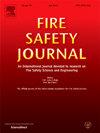评估氧化剂对燃烧固体的火焰几何形状和流出物组成的影响
IF 3.4
3区 工程技术
Q2 ENGINEERING, CIVIL
引用次数: 0
摘要
扩散火焰的燃烧化学性质和几何形状是由燃料和氧化剂向火焰片的传输决定的。为了能够独立评估氧化剂对扩散火焰的影响,燃油喷射速率必须独立于气流控制。通过对合成聚合物聚甲基丙烯酸甲酯(PMMA)和聚甲醛(POM)燃烧速度的独立控制,证明了火焰几何形状可以作为氧气环境的函数系统地变化。在不同的氧化环境(177 L min - 1,0 - 20.9% vol O2)下,用恒定质量损失率(MLR)在火焰传播装置中研究了这两种聚合物。本研究借鉴了为共流燃烧器开发的框架,允许将扩散火焰的特性建立为氧化环境的功能。低氧化环境下火焰的亮度和锚定度下降,当氧浓度从20.9%降低到9.25%时,POM火焰的热流减少了14.7 kW m−2。通过将燃烧排放与火焰几何形状相关,通过使用恒定的MLR,以一种新颖的方式研究了控制固体燃烧排放的过程。本文章由计算机程序翻译,如有差异,请以英文原文为准。
Assessing the effect of oxidizer on flame geometry and effluent composition from burning solids
The combustion chemistry and geometry of a diffusion flame are dictated by the transport of a fuel and an oxidizer towards a flame sheet. To enable the independent assessment of the impact of an oxidizer on a diffusion flame, the fuel injection rate must be controlled independently of the airflow. Through the independent control over the burning rate of the synthetic polymers polymethylmethacrylate (PMMA) and polyoxymethylene (POM), it is demonstrated that flame geometry can be systematically varied as a function of the oxygen environment. Both polymers were studied in the Fire Propagation Apparatus using a constant mass loss rate (MLR) under varying oxidative environments (177 L min−1, 0 – 20.9 % vol O2). This study draws upon frameworks developed for co-flow burners, allowing the characteristics of a diffusion flame to be established as a function of the oxidative environment. Flames sustained under lower oxidative environments displayed decreased luminosity and anchoring, with the heat flux from the POM flame decreasing by 14.7 kW m−2 as the oxygen concentration decreased from 20.9 % to 9.25 %. By relating combustion emissions to the flame geometry, through the use of a constant MLR, the processes controlling the emissions from the burning of solids have been studied in a novel manner.
求助全文
通过发布文献求助,成功后即可免费获取论文全文。
去求助
来源期刊

Fire Safety Journal
工程技术-材料科学:综合
CiteScore
5.70
自引率
9.70%
发文量
153
审稿时长
60 days
期刊介绍:
Fire Safety Journal is the leading publication dealing with all aspects of fire safety engineering. Its scope is purposefully wide, as it is deemed important to encourage papers from all sources within this multidisciplinary subject, thus providing a forum for its further development as a distinct engineering discipline. This is an essential step towards gaining a status equal to that enjoyed by the other engineering disciplines.
 求助内容:
求助内容: 应助结果提醒方式:
应助结果提醒方式:


